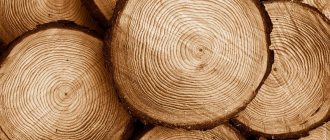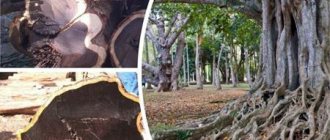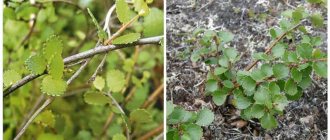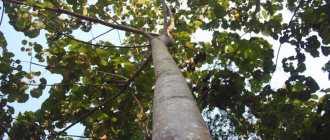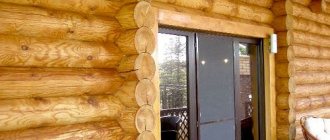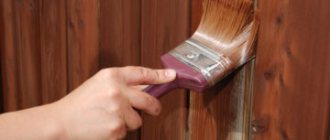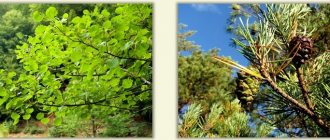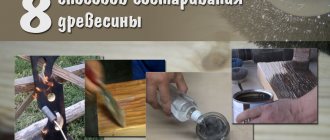Karelian (“Korelian”, warty) birch is a variety of silver birch, which has characteristic thickenings on the trunk (burls) and a rare tangled, twisted texture. It is distinguished by an amazing pattern obtained due to the intricate interlacing of fibers. This tree is a very hard and viscous material.
Karelian birch is a state value. The tree is under observation and study. This situation happened because thousands of trees were cut down due to the value of the wood. This fact has put the species at risk of complete extinction.
Botanical description
The bark of young Karelian birch trees is reddish-brown in color; a layer of light birch bark grows on the trunks by 4–5 years of age. Adult specimens reach a height of 5–7 m . In favorable conditions, their growth is 18–20 m. Within one micropopulation, trees form many different forms:
- multi-stemmed, resembling giant bushes;
- lyre-shaped: with spiral tortuosity of trunks;
- short-barreled;
- patterned;
- ribbed.
Some forms are indistinguishable from silver birch, others have characteristic unusual shapes. The crowns of the Karelian breed are sparse and torn. The leaves are light green, small, heart-shaped, with finely toothed edges, arranged alternately. In spring, young foliage emits a light fragrant aroma . The bark is rougher than that of other birches. From a young age, the entire length of the trunks has many ellipsoidal pitted depressions, nodular thickenings, nodules and nodules, prominently visible under the bark and similar to large warts. Because of this, the Karelian variety is often called warty. In the lower part there are usually more compactions and sagging; with height, the relief decreases.
Karelian birch is frost-resistant and adapts perfectly to any adverse natural conditions .
It can grow on the poorest rocky soils, among boulders, in mountain crevices. Trees older than 5 years of age tolerate long-term droughts well, due to the low evaporation of moisture from the leaves. Younger shoots dry out quickly in extreme heat, since their juices flow more intensely. The lifespan of the breed is about 50 years.
Description of the species
The unprepossessing Karelian birch looks unusual; there are spherical thickenings on the trunks, by which it can be distinguished from the ordinary birch that everyone is familiar with. On these growths, the bark has cracks and sticks out strongly, the trunk of the Karelian birch is uneven, but it will be possible to determine the species only after 8 years of the tree’s life.
Karelian meat is not often found, and it is sold in kilograms, and not like the others - in cubic meters. The main difference between Karelian birch and its ordinary relative is the wood pattern. Wooden marble is obtained due to the characteristics of the wood fibers; they are twisted together, spots, ticks and winding lines are visible on the cut.
No one has yet been able to determine what these inclusions are. Some scientists claim that this is a disease, others are inclined to genetic mutation, and still others blame it on insufficiently nutritious soil.
Despite all the characteristics of its wood and properties, a completely ordinary pendulous representative of its genus can grow from a seed. The value of this tree is also determined by its rarity. Karelka does not form a grove, grows in small groups and is extremely rare.
The wood differs in color between different specimens of the same genus. It is hard and difficult to split, but it is a pleasure to work with; craftsmen love this material for its pliability and extraordinary beauty.
Feature of wood
The tuberosity of the trunks, which deprives the trees of their external attractiveness, indicates the presence of special patterned wood. Its annual layers are wavy, the fibers have a diversified direction, the medullary rays grow into the soft parenchymal tissue. Texture – with many curls and contrasting dark inclusions. Transitional plant forms: from bush-like to woody; short-trunked specimens have the most pronounced pattern. It is formed in the fifth year of growth. Wood pulp reaches maturity by 15–20 years.
This patterned wood structure is considered atypical . There are theories according to which such structural anomalies are caused by the influence of radioactive gas - radon rising from the lithosphere, the activity of microorganisms, chromosomal mutations, and sudden changes in seasonal temperatures. The seed material of this tree does not always retain its species characteristics: the offspring can grow without sagging or patterning. Therefore, many botanists consider the mutation theory to be preferable.
Is the Karelian variety an anomalous form of ordinary birch?
This plant is characterized mainly by low growth and a crooked trunk with numerous tubercles and round swellings. Some scientists believe that the classic Karelian birch, whose height does not exceed three to seven meters, is not a separate species of tree at all, but just an anomalous form, formed under certain conditions from the usual silver birch. The small size is explained by the fact that a weakened tree lives only about 40 years and grows slower than its usual “relatives”, so it does not have time to grow taller.
Prevalence
The natural growth area of Karelian birch includes the north-west of the European part of Russia, Belarus, the countries of Scandinavia, the Baltics, and Ukraine. It can be found in Karelia, Bryansk, Leningrad, Kaluga regions, in the southern part of the Carpathians, Poland.
This species does not form dense large thickets .
It lives alone or in small groups scattered over vast areas, on rugged hilly areas, in open forests, and is adjacent to other species of birch. Because of this, it can be difficult to detect. Prefers moderately fertile sandy or loamy soils. It has been noticed that Karelian birch can often be found in areas of former forest clearings, fires, and abandoned agricultural lands.
Travel around Karelia
A Karelian birch tree grows under my window. It is still young, not tall, but spreading and with a dense crown. Together with other birch trees, it decorates the park. This birch tree is especially dear to me because it was saved from certain death. Once, my good friend Yu. A. Sidorov, with whom we live in the same house, told us some unpleasant news: the barrel of the Karelka had been sawed off. It was not possible to determine who the poacher was. One thing was clear: the birch tree needed urgent help! Having carefully examined the deep wound on the trunk and seeing that the trunk had been sawed down by more than half, I doubted the success of the operation. But it was spring, the leaves on the branches were just beginning to bloom, and this gave some hope. My neighbor and I carefully closed the wound, covered the damaged areas on the trunk with adhesive tape, put up supports, trimmed the lower part of the crown with pruning shears, watered the birch abundantly and began to wait for the result. A week passed, then another. Finally, the diseased tree, although belatedly, nevertheless turned green and successfully completed its growing season that year, and the following spring began to grow again and even began to bear fruit. Karelian birch is a tree to which nature has given the amazing beauty of wood. This beauty amazes with its originality. You look at the cut of the “karelka”, at the fancy curls, dashes, ovals or at the “stars” of the cross section - and it seems that the tree is glowing from the inside. This “play” of a pattern reminiscent of marble, this shine and shimmer, a pleasant golden hue ensures an unlimited demand for wood from Karelian birch, which is used for finishing furniture, but more often for the manufacture of art products and souvenirs. The very name of the tree indicates that the birch is ours, Karelian. Everyone who comes to Karelia for the first time tries to see the famous “Karelian woman”. During my work in the Kivach State Nature Reserve, I had to conduct many excursions with tourists from many cities of the country. And the groves of Karelian birch grown near the building of the Museum of Nature, next to the Kivach waterfall, have always aroused constant interest. As they say, having seen a real “Karelian tree” here with their own eyes, its uneven, lumpy trunk and branches, many abandoned their misconceptions that all birches growing in Karelia are “Karelian”. The guides inform visitors that from the seeds of Karelian birch, sown in 1956, along with “Karelians”, ordinary birches also grew, that when growing Karelian birch, trees should not be culled early, since Karelian birch grows slower than usual and may not show its characteristic signs. in the first years of life, and much later, even at the age of 30, and they intensify over the years. In this case, it all depends on the degree of illumination and the power supply area. In the “Museum of Nature”, tourists look at samples of Karelian birch wood, get acquainted with its various life forms from photographs, and with a map of the distribution of this tree in our republic. Natural Karelian trees also grow on the territory of the reserve. Thus, on the shore of Lake Munozero, a tall Karelian birch tree with a trunk diameter of about 40 centimeters was discovered. The large size of the tree (the height reaches 18 meters), the thick bark with deep cracks, the forked top, the uneven surface of the trunk, which has large spherical nodules - everything spoke not only of the advanced age of this Karelian birch, but also of its being one of the most valuable and rare natural monuments. Throughout the entire territory of Karelia, there can be no more than a dozen such cereal trees belonging to the “plus” category. The reserves of Karelian birch wood are still very modest. It still remains a rarity, a “pearl” of Karelian forests. The amount of wood harvested under special permits from the Council of Ministers of the KASSR is expressed not in cubic meters, but in kilograms. But in 10-15 years the situation will change. The republic's forestry enterprises and school forest districts are successfully engaged in the artificial cultivation of Karelian birch. More and more often it can be found in forest plantations, in school plots, on streets and squares. At the Forest Institute of the Karelian Branch of the USSR Academy of Sciences, the scientist-breeder V.I. Ermakov developed a method for the accelerated cultivation of Karelian birch, which ensures the mass propagation of this tree by grafting “Karelian” branches onto young trunks of ordinary birch. As a result of this operation, scientists say, different clones of this valuable species are obtained. Good results have already been achieved. If, when sown with seeds, only 30-40 percent of plants inherit the “Karelian” characteristics, then when propagated by branches, all birch trees become Karelian. All Karelian birch trunks are registered; there are only about seven thousand of them in Karelia (1988). Felling is carried out only with special permission from the government of the republic. Karelian birch is a phenomenon that still remains a mystery to science. Places of natural growth and artificial plantings (for example, near the village of Tsarevichi) have been declared nature reserves. Karelian birch is listed in the Red Book of Karelia K.A. Andreev » Rare trees of Karelia «
This tree has gained worldwide fame thanks to its rich palette of golden shades and intricate texture, with a pattern reminiscent of marble (dark brown inclusions on a light yellow background). In addition, Karelian birch differs from its ordinary sister in hardness and strength. For these valuable qualities, Karelian birch from ancient times in Rus' was called the Tsar's tree. Karelian birch belongs to a special form of warty birch. This is a low tree up to 5-7 meters high, which resembles the shape of a bush. It grows singly or in small groups. Does not form continuous thickets.
The trunk of the Karelian birch has irregularities in the form of tubercles or spherical swellings. Karelian birch grows not only in the forests of Karelia, but also in Belarus, and you can also find single specimens in central Russia and even in Siberia. For what reason an ordinary birch turns into some kind of miracle of nature, no one has fully figured out. All attempts to specifically grow Karelian birch have led to nothing, since even seeds taken from Karelian birch sprout ordinary white birch.
The structure of Karelian birch is very individual for each tree individually - the color ranges from light to dark, large, medium and finely patterned inclusions are possible.
Characterized by a pronounced pearlescent luster. The pattern in the form of dots, commas and other symbols seems to have been burned onto the surface of the wood with a burning apparatus by nature itself. Unlike ordinary birch, Karelian birch is not susceptible to rot. In addition to its high strength, it is practically not subject to corrosion at all. Karelian birch is difficult to process, but furniture made from it will be almost eternal. Even for scientists, its origin is not entirely clear - whether it is a viral disease of the plant, or a genetic mutation, the influence of growing conditions, cosmic radiation or some other anomalies. Only 5-7% of the seeds grow into a tree that has the characteristics of a Karelian birch. From the rest the most ordinary birch grows. Only an experienced forester can find individual specimens among ordinary birches by looking at subtle thickenings on the trunk and branches. Karelian birch grows more slowly than ordinary birch, and may show its characteristic signs not in the first years of life, but after several decades, and these signs intensify over the years. Long-term exploitation of Karelian birch reserves at the end of the 19th and beginning of the 20th centuries and later, especially during the Great Patriotic War and temporary occupation, led to a significant reduction in its resources in the Republic of Karelia. At the end of the 50s, there were almost no Karelian birch trees left suitable for felling.
Among the particularly hard-hit areas were the seed areas of the Zaonezhsky region, where the seed trees with the best height and wood texture were cut down and taken away. During the same period, Karelian birch practically disappeared on the territory of the former Kizhi village council.
Intensive logging resulted not only in a reduction in the number of Karelian birch, but also in many cases in a change in their habit, since after the selection of trees with large sizes and better wood grain for felling, many low-growing Karelian birch trees, mainly coppice, appeared in natural populations origin. This circumstance gave, in all likelihood, the basis for the idea of the Karelian birch having a low stature, a curved, irregularly shaped trunk, etc.
Notes from the average person. I didn’t think we had so much Karelian birch! The Internet is simply filled with parquet flooring, furniture, souvenirs and just blocks of poor wood. I’ve been wandering through the Karelian forests for 25 years now, and you know, there’s not enough birch there to make parquet out of by carloads. Enough for souvenirs, but for parquet? I even found a table made of burl on the Internet, sold under the guise of Karelian birch. So, gentlemen, be careful. Not everything is speckled birch. And further. I talked with people who were directly involved in the issue of Karelian birch. These are their words. “It’s a stretch for some trinkets, but that’s enough, but parquet? This is absurd or criminal"
Flora of Karelia | Birch | Spruce | Pine | Aspen | Alder | Linden | Rowan | Willow | Poplar | Maple | | Bird cherry | Larch | Elm | Juniper | Karelian birch || Lingonberry Blueberry | Astragalus Ledum Elecampane | Fireweed St. John's Wort Lily of the Valley | Cattail Heather Rhodiola rosea | Cornflower Watch Carnation grass | Angelica Hedgehog forest wild strawberry | Oxalis Kostyanika Yellow Capsule | Meadowsweet Linnaeus northern Maynik | Soapwort Lungwort Bluegrass | Moss Tansy Pikulnik | Chamomile Arrowhead Timofeevka | | Tricolor violet China meadow succession | Celandine Sorrel Yarutka | Air | Valerian | Blueberry watch | Knotweed Clover Cranberry | Polyanika Nettle | Cinquefoil Buttercup Raspberry Mother and Stepmother | Wheatgrass Sabelnik | Bearberry Yarrow | Horsetail Blueberry Rosehip | Reed Kaluzhnitsa | Cloudberry Dandelion Plantain | Elderberry Blackberry | Poisonous plants |
It is worth looking at the following material:
Karelian birch. The state of resources and their protection The tourism infrastructure of Karelia is reaching the world level Rent a motor ship in Karelia and fishing on Lake Onega Map of Vygozero with depths Camping bathhouse PB-2. Installation, operation, reviews. Rock paintings of Karelia. Discoverers. Maps of Karelia
Historical facts
Under the names of birch, svil and naplava, this type of tree has been known and popular in Russia since the 18th century. Valuable wood was considered as a means of payment, along with money . The name “Karelian” was officially received by the plant in 1857. There is reason to classify this variety as a relict tree that has lived on the lands of the modern Leningrad region and other territories since the end of the Ice Age.
In Karelia, natural populations of the tree were endangered during the Great Patriotic War, when the northern territories were under occupation. The birch was actively cut down; it did not have time to recover on its own, which is why it is currently considered a rare plant.
Distribution of Karelian birch
Karelian birch grows in Russia, Northern Europe; in Central Europe it is found in small groups. It is found quite a lot in Belarus. The range is limited to Norway and Finland, the southernmost point is in Slovakia, and in Russia it grows to the Kostroma region and in the north to Karelia.
The largest number of trees is found in Belarus, as well as in horticultural organizations of the Republic of Karelia. Natural growth on the territory of Russia is limited to 3 thousand copies.
The unprepossessing “beauty” prefers pine forests; the soil should be well-drained; it is more often found on gentle hills. It avoids wetlands and prefers fertile soil. Prefers gray alder as neighbors.
Properties and structure of wood
This is one of the most durable and hardest types of wood. The density of Karelian birch is about 770 kg/cu. m. The Brinell indicator is 3.5 units. It is heavier than oak, very viscous, and is not subject to swelling, corrosion, rotting and various types of deformation.
The shade of the dried massif ranges from chocolate brown to golden, grayish-pink, reddish, light yellow and cream with a pearlescent sheen. Thanks to the burls - dense dark inclusions, as if sprayed throughout the entire structure of the wood - the surface appears marbled. The intertwined twisted and wavy fibers create a unique relief pattern.
Treatment
Due to its high density, viscosity and heterogeneous structure, Karelian birch is considered one of the most stubborn tree species. Drying takes a long time and is carried out only under natural conditions for several weeks.
Curly multidirectional fibers create great difficulties during manual and mechanical cutting and turning of the material. If the blades of working tools are not sharp enough, the surface may become fleecy. It is not easy to split a mature dry Karelian birch with an ordinary ax. It holds fasteners perfectly, which is facilitated by almost stone hardness. The smooth surface of wood lends itself well to polishing, varnishing and painting.
Application
Karelian birch is an expensive and sought-after species, along with valuable exotic species of pink or mahogany. Its rarity, unique unique design and high technical characteristics determine the cost. The price of 1 cubic meter of material starts at $1,500, so sales are often made in kilograms.
Karelian birch is used to make artistic design items, souvenirs, boxes, figurines, cases, cigarette cases, wooden parts of exclusive sports equipment and musical instruments.
Karelian birch veneer is used in the production of finishing panels and in the furniture industry.
Landing
Growing Karelian birch is simple and difficult at the same time. They are mainly bred in special nurseries. The pedigree of shoots sprouted from seeds is not guaranteed. Patternedness is retained in approximately ⅓ of seedlings. The remaining trees are ordinary silver birches.
Planting of the material can be done in spring and autumn. Birch is undemanding in terms of soil composition, but it requires light, so open areas should be chosen for it.
Holes for seedlings are dug 1.5 times larger than the root system . When planting in groups, a distance of 3–4 m is maintained between the holes. When planting, you can add rotted compost, leaf humus or mullein to the soil, add urea, and ammonium nitrate. After finishing the work, the plants are watered abundantly.
Planting and growing
Growing Karelian birch is long and difficult. The peculiarities of wood are noticed no earlier than 8 years, and the tree is extremely selective and demanding of its location. There are few nurseries that breed it, and in Russia imported material from other countries is more often used. Karelka is propagated in two ways - by seeds and vegetatively.
Growing with seeds
You can only use fresh seeds for planting Karelian birch; after a year they will no longer give any results. It is typical that if you collect a seed from a separately growing tree, only 3% will sprout, but if it is possible to find a group of trees, then the probability of sprouting increases to 25%. Of these, about 80% will have pronounced signs of expensive wood.
Another feature of seed growing is a clear lag in growth, but the diameter of the tree is exceeded. After some time, this deficiency is compensated. As a result, it becomes possible to identify the Karelian moth earlier than in its wild habitat.
Care
In the first few years, Karelian birch should be protected from drying out, moisturizing it in dry, hot weather. To better conserve water in the soil, it is recommended to mulch the tree trunks with pine needles, peat or sawdust. With normal rainfall in the region, additional watering is not required for seedlings.
Periodically, 1-2 times a season, it is advisable to apply complex mineral fertilizers to the soil; they will stimulate the growth of seedlings.
Formative pruning of birch trees is not practiced. They recover rather slowly, and if the damage is severe, the trees may die. It is recommended to trim only freezing and diseased shoots. This should be done in early spring, before sap flow begins. After sanitary treatment, the cut areas must be lubricated with garden varnish.
Karelian birch does not require special protection for the winter; it tolerates the cold successfully. Young plantings can be covered with snow in frosty weather.
Reproduction
The plant is propagated by seed, grafting and cuttings. The first is more suitable for nurseries, as it allows you to get many new seedlings at once. Pollination and seed maturation are controlled. Before planting, the material is stored in the cold for three months. Sowing is done in open ground to a depth of 1–1.5 cm. About 1 gram of seeds is used per 1 m². The emerged seedlings dive.
Vegetative propagation gives a greater chance of retaining patterning characteristics in new plants. For grafting, green cuttings from the upper parts of tree crowns are used. They are prepared in mid-spring. The material is grafted into clefts on the stumps of old trees or behind the bark. Open sections are covered with plasticine or tied with film.
Karelian birch cuttings do not root on their own . Reproduction by layering and shoots is more successful. For this purpose, mature trees at least 15 years old are used - usually those that are planned to be cut down. For propagation, several shoots or lateral shoots are left, which are stimulated for further growth.
